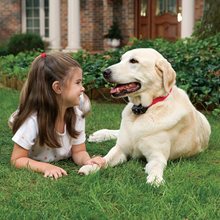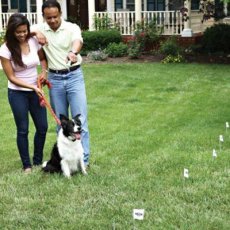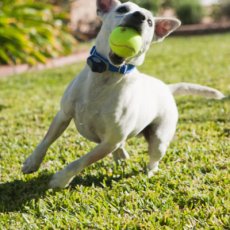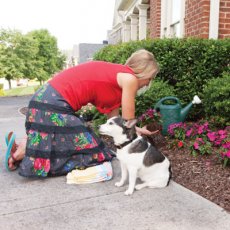Ways to train Your dog
 Congratulations on your new PetSafe containment system! Proper training of your pet is essential to the success of your PetSafe fence. Have fun with your pet throughout the training process.
Congratulations on your new PetSafe containment system! Proper training of your pet is essential to the success of your PetSafe fence. Have fun with your pet throughout the training process.
Training should be fun, fair, firm, and consistent. While we suggest a minimum of 14 days of training, depending on how your pet learns, the training could take more or less time. Don’t try to do too much too quickly.
Train for 10 to 15 minutes at a time. Short, frequent sessions are better than longer, less frequent sessions. If your pet shows signs of stress, slow down the training schedule, add additional days of training, or increase the amount of play time with your pet in the Pet Area. Common stress signals include:
- Pet pulling on leash toward the house
- Ears tucked
- Tail down
- Body lowered
- Nervous / frantic movement
- stiffening of pet’s body
Your pet must be completely comfortable near the Boundary Flags at the end of every training session. To make sure he’s comfortable, spend at least 5 minutes of “play time” at the completion of each session within 10 feet of the Boundary Flags.
You must also finish each training session on a positive note with lots of praise and play. Even if you think your pet is responding well to the training, complete the entire training. Reinforcement is important!
Before training, put a separate non-metallic collar on your pet’s neck above the Receiver Collar and attach a leash. Make sure you have tiny treats that your pet will find desirable (hot dogs or lunch meat work well), as well as your pet’s favorite play toy.
 Day 1 - Boundary Awareness, Tone Only Training Mode
Day 1 - Boundary Awareness, Tone Only Training Mode
Perform 3 10-15 minutes sessions on the first day of training. The goal of this first training session is to have your pet learn that the Boundary Flags and warning beep from the Receiver Collar define the new Pet Area. Program the Static Correction Level on the Receiver Collar to Level 1, tone only training mode.
- Begin by walking your pet on a leash in the Pet Area. Calmly praise and talk to your pet and move toward the Boundary Flags. Be sure to keep the mood happy.
- With full control of your pet on a leash, walk to the flags. As your pet enters the Boundary Zone, the Receiver Collar will begin to beep. Allow your pet to stay in the Boundary Zone for up to 2 seconds, then gently help him back into the Pet Area.
- Immediately praise and offer your pet a treat as he enters the Pet Area, even if you have helped with the leash.
- Repeat this process at the same Boundary Flag until your pet resists going into the Boundary Zone. Then move on to another flag. Aim to master 3-4 Boundary Flags per session. Be sure to make this FUN!
 Days 2 - 4 - Continue Boundary Awareness, Introduction to Static Correction
Days 2 - 4 - Continue Boundary Awareness, Introduction to Static Correction
Perform 3 10-15 minutes sessions every day during this phase of training. The goal of this phase is to train your pet to stay in the Pet Area and to respect his boundaries. Program the Static Correction Level on the Receiver Collar to Level 2.
- Repeat the steps in Phase One. If your pet does not respond to the Static Correction, confirm that the Receiver Collar is fitting properly. If the Receiver Collar is fitted properly and your pet does not respond to the Static Correction, increase the Static Correction Level by 1.
- Watch for slight reactions at first such as ears up, head turned, looking at the ground. Stay at the same flag until your pet resists going into the Boundary Zone.
Days 5 - 8 - Distraction Phase
Perform 3 10-15 minutes sessions every day during this phase of training. The goal of this phase is to train your pet to stay in the Pet Area with distractions outside of the Pet Area. Be sure you use external distractions and never coax or call your pet out of the Pet Area. Program the Static Correction Level on the Receiver Collar to Level 2 or higher, depending on the reaction results from days 2 through 4.
- Create distractions to tempt your pet to enter the Boundary Zone while maintaining full control of your pet on a leash. Have a family member cross from inside the Pet Area to outside of it, throw a ball or treat outside the Pet Area, or have a neighbor walk their pet outside the Pet Area.
- If your pet does not move toward the distraction, praise and offer a treat. If your pet does react to the distraction, allow him to go into the Boundary Zone.
 Help your pet back into the Pet Area if he does not turn back after 2 seconds.
Help your pet back into the Pet Area if he does not turn back after 2 seconds. - Treat and praise your pet anytime he comes back into the Pet Area with or without help.
- Repeat this process with other distractions.
- Gradually increase the distraction level as your pet continues to ignore the distractions and return to the Pet Area.
- If your pet does not respond to the Static Correction, confirm that the Receiver Collar is fitting properly. If the Receiver Collar is fitted properly and if your pet does not respond to the Static Correction, increase the Static Correction Level by 1. Don't increase the level by more than 1 level at a time. Stop and go back to the previous level if your pet shows any signs of fear or distress
Days 9 - 14 - Unleashed Supervision
Training sessions should start at 10-15 minutes, gradually increasing to over an hour. Your pet is ready for this step only when he clearly avoids the entire Boundary Zone, regardless of any distractions or temptations. During this step, do not leave your pet unattended. The goal of this phase is to give your pet free run of the Pet Area off the leash.
- Enter the Pet Area with your pet wearing the Receiver Collar at the appropriate Static Correction Level. Walk around the yard and play with your pet, staying within the Pet Area at all times.
- Preoccupy yourself with another task in the yard while watching your pet.
Days 15 - 30 - Pet Monitoring
At this stage your pet is ready to run free! You need to keep an eye on your pal when you let him out, but do not have to be outside with him.
Once you are satisfied that your pal understands his boundaries, begin removing every other Boundary Flag every 4 days until all the flags are gone. Make sure you put the flags somewhere safe in case you need to use them again in the future to train another pet or to help retrain your pet at a new home or when you're on vacation.
Related posts:

 MARY ISENHOUR-LONG Owner - Trainer Photo by Stewart Event Images About The Trainer The phrase, “gone to the dogs”, is certainly an appropriate one to describe my…
MARY ISENHOUR-LONG Owner - Trainer Photo by Stewart Event Images About The Trainer The phrase, “gone to the dogs”, is certainly an appropriate one to describe my… 6 Principles of Successful Training 1. Be Consistent: Apply the same rules and the same words all the time. 2. Be Concise: Give your command just once. Repetition…
6 Principles of Successful Training 1. Be Consistent: Apply the same rules and the same words all the time. 2. Be Concise: Give your command just once. Repetition… Cesar Millan Cesar is a best-selling author, public speaker, and internationally acclaimed star of the TV shows “Dog Whisperer with Cesar Millan, ” “Leader of the…
Cesar Millan Cesar is a best-selling author, public speaker, and internationally acclaimed star of the TV shows “Dog Whisperer with Cesar Millan, ” “Leader of the… At Monument Dog Training, we believe that change is always possible . We regularly resolve aggressive behavioral issues, even with dogs who have been written off…
At Monument Dog Training, we believe that change is always possible . We regularly resolve aggressive behavioral issues, even with dogs who have been written off… After years of working with thousands of dogs and their owners, I have seen that the key ingredient people are actually looking for is how to be the Pack Leader…
After years of working with thousands of dogs and their owners, I have seen that the key ingredient people are actually looking for is how to be the Pack Leader…